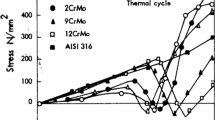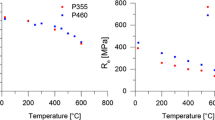Abstract
A Round Robin Programme was established by a working group of Commission X in 1997 in order to evaluate the possibilities of residual stress and distortion prediction (RSDP) in welded structures and to validate and benchmark prediction codes based on finite element simulation of the welding process. Calculations on residual tresses have been carried out on an austenitic steel plate with well-defined material and geometrical data, welding conditions and with the proposal to use the kinematic hardening model. In addition, a second programme for measurements of residual stresses in this plate has been started in 2003. Measurements have been taken on three austenitic steel plates using the X-ray measuring method as well as neutron diffraction methods and different kinds and variations of the hole drilling method. Although a rough agreement between the measured results and the calculated ones was found in principle, distinct differences have been observed in detail — especially for the longitudinal residual stresses. The calculations indicated nearly constant tensile stresses of the order of the initial yield strength in the weld seam and in the adjacent heat affected zone (HAZ). The measurements however revealed stress maxima in the HAZ with values clearly higher than the initial yield strength. Therefore additional calculations have been carried out with different hardening models in order to investigate their influence on the residual stress results. In fact, calculations performed with the isotropic hardening model could approve these stress maxima quite exactly. In further detailed investigations, it could be shown that the reason for the stress maxima is the strain hardening in the HAZ due to thermal stresses during the welding process. Finally basic considerations could explain that the kinematic hardening model, including the Bauschinger effect, cannot account for this hardening effect. Literature indicates that the Bauschinger effect is at least not fully effective at high working temperatures of austenitic steels. Altogether, the calculation programme has shown that a rough estimation of the residual stress state after welding is possible without any special distinction of the hardening model to be used. For a more precise and detailed information, the chosen hardening model is of significant relevance.
Similar content being viewed by others
References
Janosch J.J.: IIW Round Robin protocol for residual stress and distortion prediction, Phase II (Proposal Rev. 1), IIW Doc. X/XV-RSDP-59-00, 2000.
Janosch J.J.: IIW Doc. X/XV-RSDP-60-01, 2001, IIW Doc. X/XIII/XV-RSDP-68-02 / XV-1121-02 / XIII-1904-02, 2002, IIW Doc. X/XV-RSDP-68-03, 2003, IIW Round Robin Updated Results for Residual Stress and Distortion Prediction, IIW Doc. X/XIII/XV-RSDP-97-04.
Janosch J.J.: IIW “Round Robin” protocol for 3-dimensional welding residual stress and distortion prediction, IIW Doc. X/XIII/XV-RSDP-75-03.
Radaj D.: Heat effects of welding: temperature field residual stress distortion, Springer-Verlag, Berlin, 1992.
Brand M. and Siegele D.: State of the numerical round robin residual stress results, IIW-Document X-1648-08.
Goldak J., Charkravarti A. and Bibby M.: A new finite element model for welding heat sources Metallurgical and Materials Transactions B, 1984, vol. 15, pp. 299–305.
Loose T., Sakkiettibutra J. and Wohlfahrt H.: New 3D-calculations of residual stresses consistent with measured results of the IIW Round Robin Programme, Mathematical Modelling of Weld Phenomena 9, Verlag der technischen Universität Graz, Graz, 2010, pp. 369–390.
Wohlfahrt H.: Report on the Experimental Round Robin Tests on Residual Stresses 2005, IIW Doc. X/XIII/XV-RSDP-112-05, 2005.
Janosch J.J.: Round Robin phase II — 3D modelling — Updated results, IIW Doc. X/XIII/XV-RSDP-114-05, 2005.
Janosch J.J.: International Institute of Welding work on residual stress and its application to industry, International Journal of Pressure Vessel and Piping, vol. 85, 2008, pp. 183–190.
Wohlfahrt H.: New calculations checking an adequate materials law. New results on distortion measurements. Report on the Round Robin Tests on Residual Stresses 2009. IIW Document IIW-X-1668-09, IIW-XIII-2291-09, IIW-XV-1326-09.
Wohlfahrt H.: Reports on the Experimental Round Robin Tests on Residual Stresses, IIW Doc. XIII-2144-06 / XV-1227-06 / X/XIII/XV-RSDP-115-06, 2006, IIW Doc. X-1633-07 / XIII-2199-07 / XV-1263-07, 2007.
Wohlfahrt H. and Dilger K.: New results of the IIW Round Robin residual stress measurements, Report on the experimental Round Robin Tests on residual stresses 2008, IIW Doc. XII I-2241-08/XV-1283-08, 2008.
Lobanov L.M.: Report from E.O. Paton Electric Welding Institute, Kiev, for IIW Report IIW-XIII-2241r-08, IIW-XV-1283r-08, 2008.
Lobanov L.M., Pivtorak V.A., Savitsky V.V. and Trachuk G.I.: Procedure for determination of residual stresses in welded joints and structural elements using electron speckle-interferometry, The Paton Welding Journal, 1/2006, pp. 24-29.
Brand M.: Further development of methods of numerical welding simulation, PhD-Thesis, in progress (in German).
Institute for joining and welding, University of Braunschweig: Additional measurements.
Georg H. and Benedikt H.: Hinweise zur Bildung, Entstehung und Wirkung von Delta-Ferrit in austenitischen Edelstahllegierungen (Werkstoffnummern 1.4404 / 1.4435), Indications on formation and effect of delta-ferrite in austenitic alloys (Material No. 1.4404 / 1.4435), Henkel-Epol, 2003, Aufsatz Nr. 32 / Rev. 00 (in German).
Manninen T., Myllykoski P., Taulavuori T. and Korhonen A.S.: Large-strain Bauschinger effect in austenitic stainless steel sheet, Materials Science and Engineering, 2009, vol. A 499, pp. 333–336.
Mataya M.C. and Carr M.J.: The Bauschinger effect in a nitrogen-strengthened austenitic stainless steel, Materials Science and Engineering, 1983, vol. 57, pp. 205–222.
Author information
Authors and Affiliations
Corresponding author
Rights and permissions
About this article
Cite this article
Wohlfahrt, H., Nitschkepagel, T., Dilger, K. et al. Residual Stress Calculations And Measurements — Review And Assessment Of The Iiw Round Robin Results. Weld World 56, 120–140 (2012). https://doi.org/10.1007/BF03321387
Published:
Issue Date:
DOI: https://doi.org/10.1007/BF03321387




